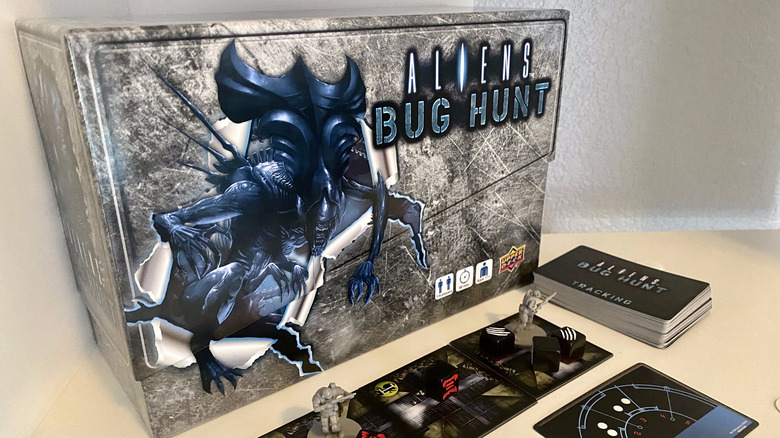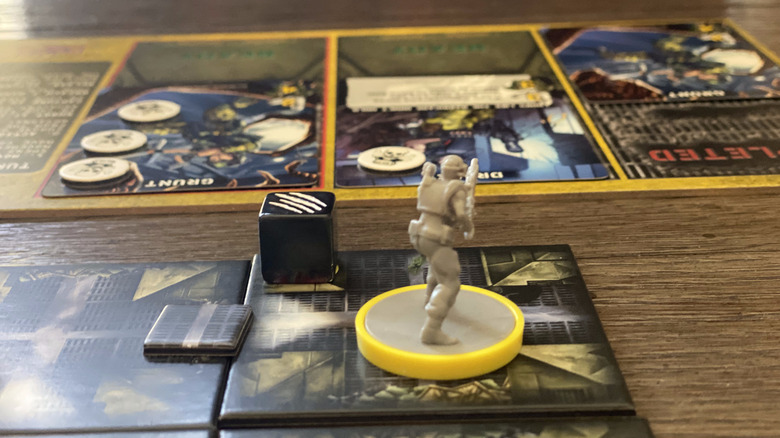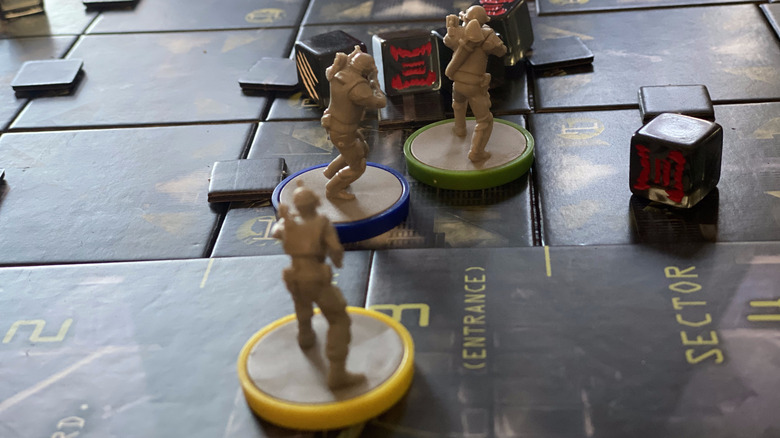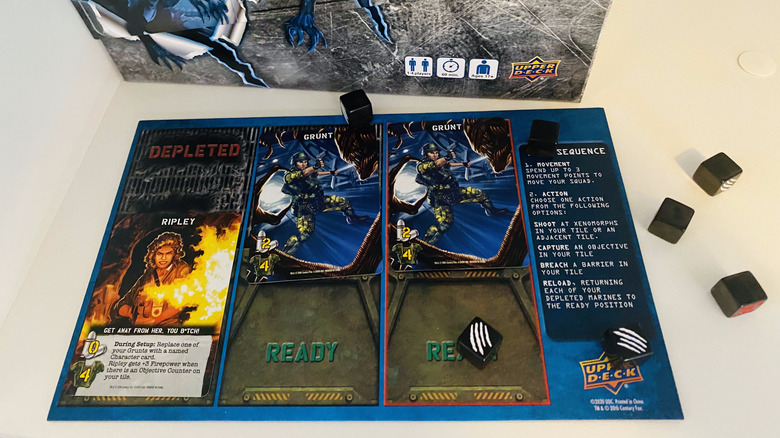Aliens: Bug Hunt Is The Alien 'Dungeon Crawler' Board Game You've Always Wanted
It's good to have professional goals in life. One of mine is to eventually review every licensed "Alien" board game ever released. Honestly, it's a more challenging proposition than you might think. Depending on how wide you cast the net, you might include out-of-print games like the 1997 "Aliens Predator Customizable Card Game" or 2015's "Alien vs Predator: The Hunt Begins." Even the first "Alien" board game — a 1979 Kenner release inexplicably positioned for ages seven and up — is hard to find outside of a drunken eBay splurge.
Thankfully, there's the (somewhat defunct) Upper Deck Entertainment license for those of us on a budget. I've previously sung the praises of "Legendary Encounters: An Alien Deck Building Game," which builds on the popular Legendary system to create fun adaptations of each "Alien" movie. But just as compelling is "Aliens: Bug Hunt," a 2020 release from designer Ryan Miller that combines dungeon crawler and tower defense mechanics to bring the frantic gunfights of "Aliens" into a fast and friendly game for your table.
Step into the shoes of the Colonial Marines
In "Aliens: Bug Hunt," you and your group play the Colonial Marines from James Cameron's film as they search for the missing colonists on LV-426. At the start of the game, players will choose one main character and two grunts for their player board and begin to explore the five sections of the colony. The player action economy is simple: your miniature has three points of movement that can be used to move, reveal new tiles, or navigate tough terrain. Each squad also has one collective action, which players will primarily use to shoot, reload, and clear in-game obstacles as they advance.
Success in "Aliens: Bug Hunt" boils down to how well you manage your player boards. Think of your squad as some combination of your health bar and ammo; each time you shoot with a character, that character gives you the number of attacks present on the player card. This requires you to move that character from the Ready section of your board to the Depleted area when finished. You always have the option of taking the reload action — which readies all characters in your squad — but with only one action available each turn, a smart player may choose to hold some firepower in reserve if the board goes sideways on them.
And gunfire in this game is anything but automatic. Each xenomorph on the board is represented by a single dice, which players roll to determine the fate of their squads. If this result is a blank die face, your soldier successfully kills a xenomorph. Roll a white claw or red bite mark, however, and your character may get rebuffed or even injured during their attack. This makes combat in "Aliens: Bug Hunt" a battle of attrition, often determined by when and how you use the special powerups — such as destroying extra xenomorphs on a specific tile — located on each randomized mission card.
Sci-fi dungeon crawling at its finest
To win, players must capture — use an action on — all nine objective tiles on the map. But standing in their way is a neverending army of xenomorphs. Each turn, xenomorphs will come crawling out of the woodwork; randomized tracking cards determine the number and location of new xenomorphs in each section, and players will assign the revealed number of dice at hive locations across the map. "Aliens: Bug Hunt" captures the confidence-to-catastrophe narrative of the film by allowing players to be confident early on — but as more xenomorphs sneak off the board, the in-game difficulty mechanic slowly begins to escalate.
In both playthroughs, our group raced to return to the ship before being overwhelmed by the escalating number of xenomorphs. You know you've made a proper "Aliens" game if everyone dies and I still had a good time.
As with any good dungeon crawler, replayability for "Aliens: Bug Hunt" is key. Thankfully, designer Ryan Miller has built in a handful of well-randomized mechanics. The first is the deck of LV-426 location tiles. Since players randomly draw and place tiles as they explore the colony, no two "Aliens: Bug Hunt" games will play alike. Depending on the board's layout, strategies that worked in one game — such as ignoring or breaching barriers to create pathways back to the ship — may be useless during your next playthrough. Modular game boards are hardly a new concept in board games, but the uncertainty this creates for players taps nicely into the film's atmosphere.
But perhaps my favorite mechanic is the Tracking Deck. Few pieces of sci-fi technology in film history can match the tactile and auditory pleasures of the "Aliens" motion tracker, and using a facsimile of the motion tracker to spawn new xenomorphs is the perfect marriage of theme and mechanics. Since the xenomorphs are constantly in motion toward the Colonial Marines' ship, the Tracking Deck also adds a little tower defense flavor to the game. Do you position yourself between the aliens and the ship to prevent the hive track from advancing? Or do you risk pushing the squad just a little further out in the hope of finding that very last checkpoint?
Swing-and-a-miss rulebook
Granted, not every attempt to balance theme and gameplay works out. The biggest frustration of playing "Aliens: Bug Hunt" is the rulebook — not the rules themselves, which are simple in the best way, but the actual design behind the booklets. I don't mind learning and teaching a new game to the table — it's always felt like the quid pro quo for making people drive to my house and move pieces of cardboard around on my kitchen table — but "Aliens: Bug Hunt" takes a genuine stab at democratizing teaching responsibilities. In addition to their characters, each player is given a rank — such as Platoon Leader or Master Sergeant — and a corresponding dossier that serves as one-fourth of the rulebook.
It's a clever idea on paper, one made better by the flavor text for each rulebook (each cover claims that your role is the most important one in the unit). Unfortunately, in practice, the shared approach to game rules is an absolute mess. New players are already struggling to master their action economy; adding the wrinkle of a partial ruleset adds chaos, especially when actions cascade into each other. Need clarity on a particular significant movement and action? Enjoy gameplay grinding to a halt as you try to locate two rule subsets in four different booklets.
(Thankfully, fans of the game have cobbled together a condensed rulebook that removes these challenges from the playthrough. It turns out the BoardGameGeek community can solve every problem known to man.)
A must-own for Aliens fans
Should you scrounge up a copy of "Aliens: Bug Hunt" for your board game group? Even the license-agnostic among us would probably admit that "Aliens: Bug Hunt" is a pretty sturdy piece of game design, but with so many options available to board gamers at every price point, even being a pretty good game these days may not be enough to break through the noise. However, if you are a fan of "Aliens" and put a premium on theme, you will be delighted with what Miller and company have created. So, while there may be many games like "Aliens: Bug Hunt" on the market, well, as the rifleman's creed goes, this one is mine.




